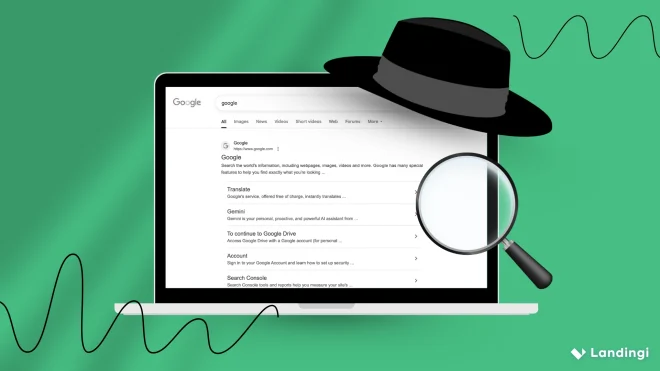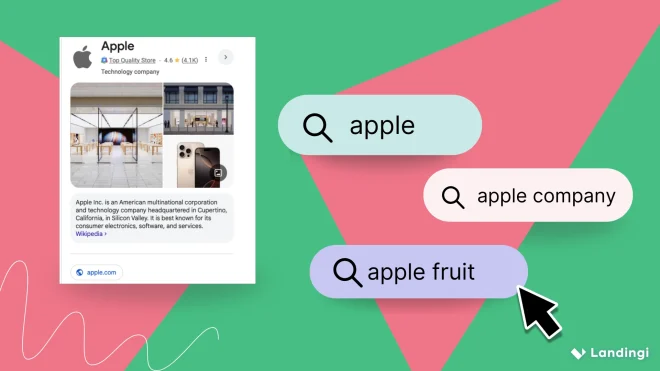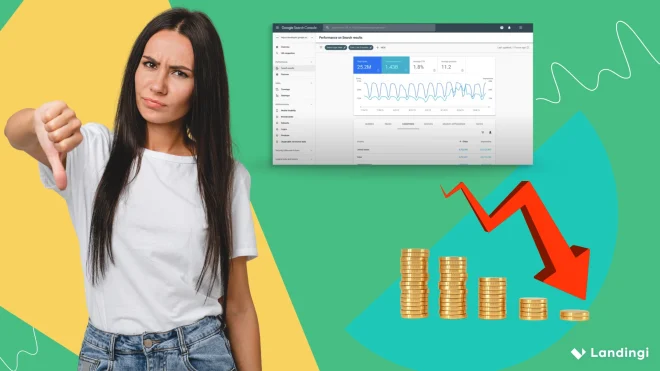For many SaaS companies, attracting high-quality traffic without overspending on ads is an ongoing challenge. Relying too heavily on paid channels can drive up acquisition costs and limit long-term growth.
That’s where SEO comes in.
SEO for SaaS companies is the process of improving a software product’s visibility in search engines so that it attracts potential users across the entire customer journey – from the first “what is…” search to the final “pricing” or “free trial” decision.
SaaS SEO marketing helps reduce customer acquisition costs and attract users with high purchase intent. As Tom Shapiro from Stratabeat notes, “SEO offers B2B SaaS an opportunity to achieve CPL at 10%–30% the cost of paid media campaigns.” That kind of efficiency makes organic search one of the most valuable acquisition channels for subscription-based products.
To make it work, your SaaS SEO strategy needs to cover technical optimization, keyword research, and content that matches intent. It should also connect organic traffic to clear conversion goals like signups or demos. You can improve performance by focusing on five key areas:
- Technical SEO
- Intent-based keywords
- Funnel-aligned content
- High-converting landing pages
- Ongoing SaaS SEO audit
In this article, you’ll learn what SaaS SEO is, why it matters, how it works, and how to improve it step by step.

What is SaaS SEO?
SaaS SEO is the process of increasing organic traffic to a Software as a Service website by improving its visibility in search engines across every stage of the buyer journey.
That means optimizing your content, technical infrastructure, and overall website experience to show up in searches related to your product. But in SaaS, SEO isn’t just about rankings – it’s about attracting trial users, converting traffic into paying customers, and aligning your content with how people actually research and buy software.
SaaS search engine optimization includes several distinct activities: technical setup to ensure search engines can properly crawl and index the site; a content strategy that covers both informational and transactional intent; structured topical maps that build authority in a niche; and continuous content updates to stay relevant.
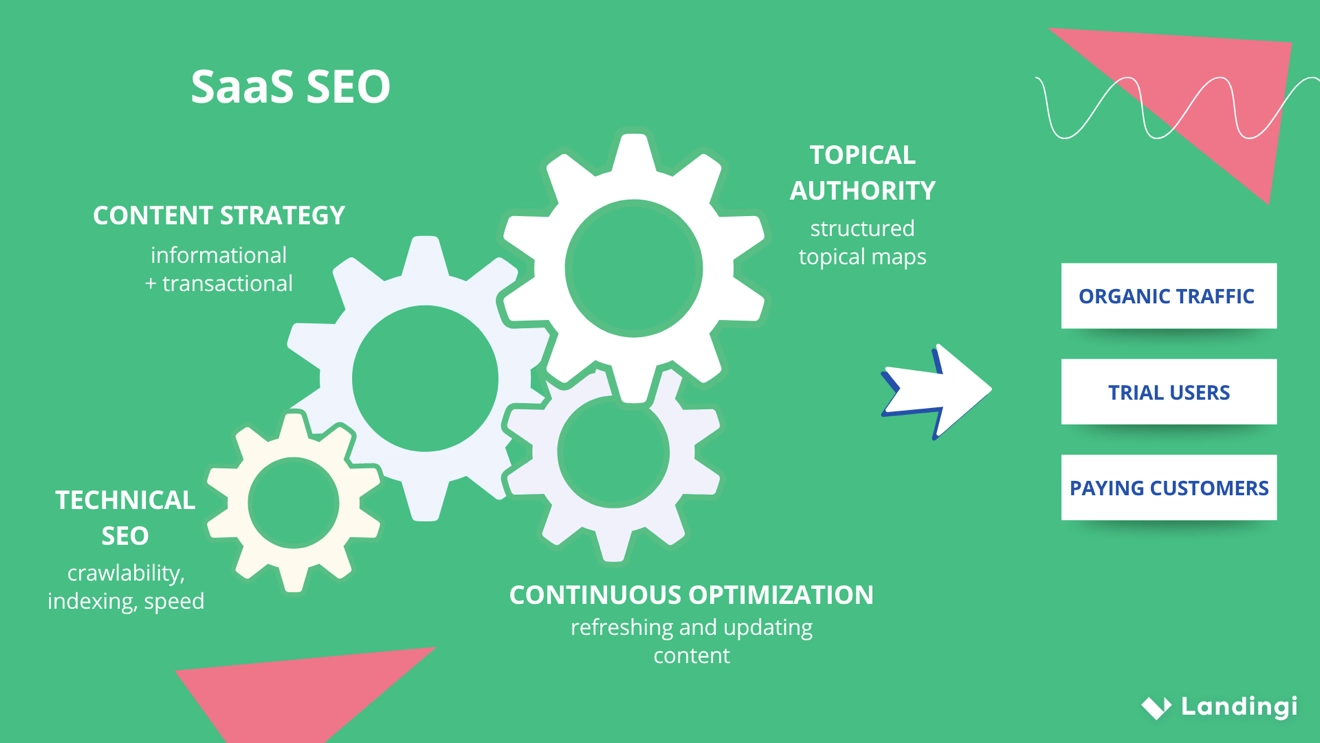
Why is SaaS SEO Important?
SaaS SEO is important because it provides scalable, long-term traffic growth and helps SaaS companies reduce their reliance on paid ads or outbound sales.
Most B2B SaaS buyers don’t want a demo right away. They Google their problems, compare alternatives, and read reviews before talking to sales. If your product doesn’t show up during that research phase, you’re invisible to most of your market.
SEO allows you to meet buyers at every stage – from “What is project management software?” (TOFU) to “Asana vs Trello” (MOFU) to “Trello pricing” (BOFU). Done well, SEO brings in users with clear intent and high potential to convert.
For SaaS businesses, SEO isn’t just a traffic channel – it’s a growth lever. It supports product discovery, brand trust, and recurring revenue over time.
Build pages that attract, educate, and convert SaaS leads without a sales call.
What are the Benefits of SaaS SEO?
Benefits of SaaS SEO are lower acquisition costs, higher-quality leads, increased visibility throughout the buyer journey, and sustainable, compounding growth.
Unlike paid search, which stops generating leads the moment you pause your ads, SEO continues to deliver traffic long after the content is published. Over time, this makes your cost per acquisition (CPA) lower and more predictable.
SaaS SEO also improves lead quality. Visitors coming from organic search often have a clearer idea of what they’re looking for and are more motivated to evaluate solutions. They’ve already begun their research, which shortens your sales cycle.
Another major benefit is full-funnel visibility. With the right SEO strategy, you can rank for early-stage queries that build brand awareness, middle-stage queries that support comparisons, and bottom-of-the-funnel queries that convert. This makes SEO not just a marketing tool but a key part of your customer acquisition system.
And unlike social media or PR, SEO results are measurable. You can track rankings, clicks, conversions, and revenue contribution with precision.
According to ScaleCrush, there are six key benefits of SaaS SEO. Here’s a closer look:
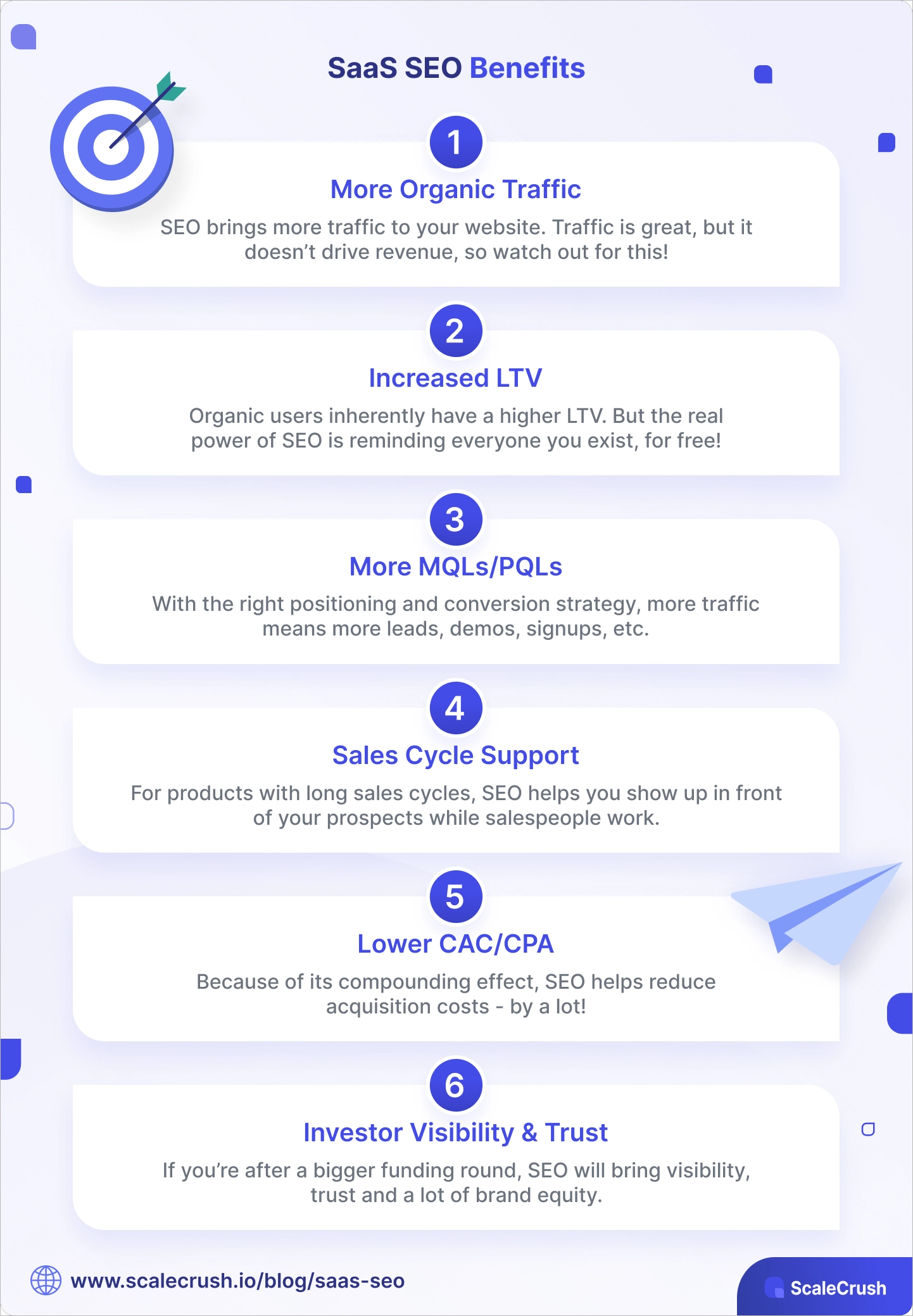
9 Steps to Create a SaaS SEO Strategy
To create a SaaS SEO strategy, follow a structured process that includes technical setup, content planning, and continuous optimization to improve your website’s visibility and performance in search.
Explore these 9 SaaS SEO strategies to improve your traffic from search engines.
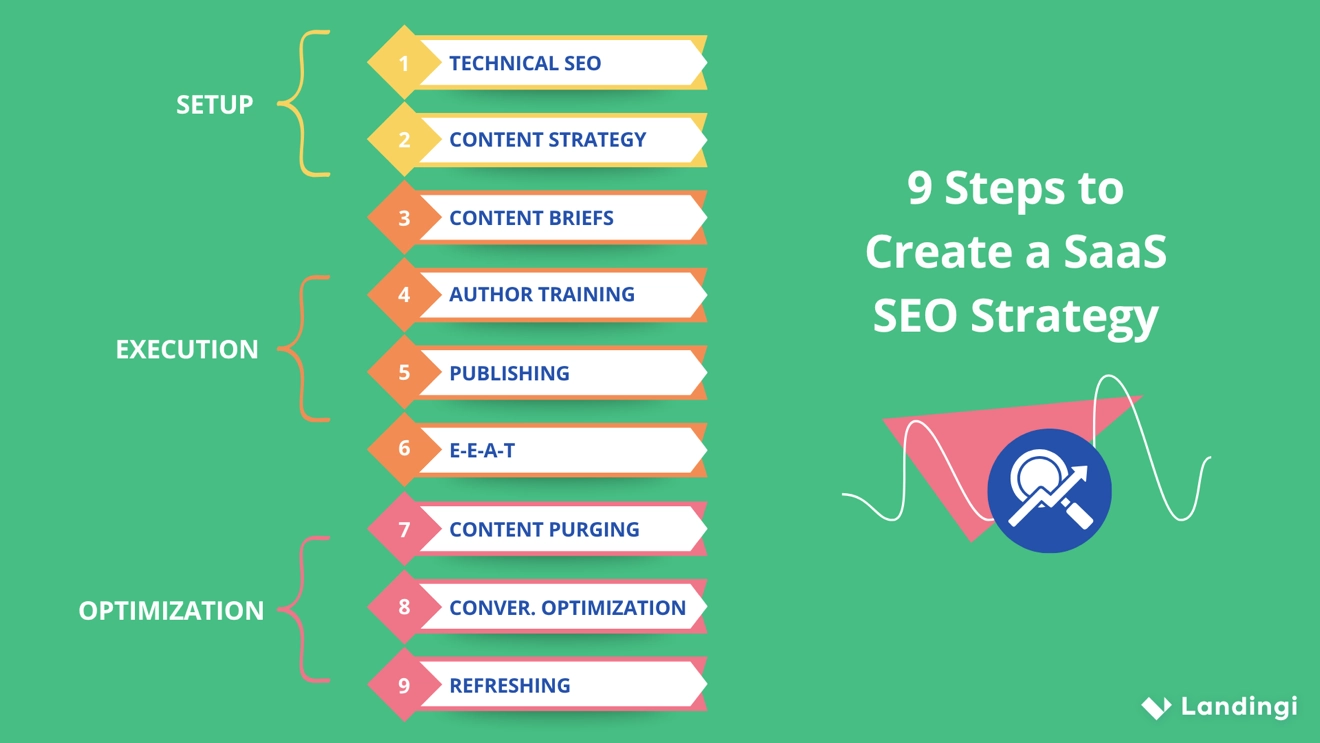
Here’s how to build a complete strategy from the ground up:
1. Set up your website with technical SEO
Before you start creating content, make sure your technical foundation is solid. Search engines need to easily access, understand, and index your site. Here’s what to do:
- Submit your sitemap to Google Search Console and other search engines.
- Make sure your pages are indexable by checking robots.txt and meta tags.
- Set up canonicals to prevent duplicate content issues.
- Implement structured data to help search engines understand your content better.
- Create a proper URL structure that’s readable and reflects your site hierarchy.
- Set up 301 redirects to consolidate link equity and avoid broken links.
- Fix Search Console issues like crawl errors, indexing problems, and Core Web Vitals.
- Optimize your crawl budget by eliminating low-value pages and guiding crawlers toward important content.
2. Create your SaaS SEO content strategy
Your content strategy is the core of SaaS SEO. Start by identifying your audience and understanding what they search for, then organize your topics to guide them through the buying journey.
a) Choose your audience
Define your target audience and tailor your language and industry terminology to match their level of expertise.
Example: If your target audience consists of a wide range of digital marketers and you’re writing an article about SEO, don’t avoid terms like SERP, crawl budget, backlinks, canonical URL, LSI, CTR, UGC, or content pillars. Instead, use them strategically to reinforce topical relevance and help search engines classify your content more effectively.
Your content strategy leads the way—your landing pages should close the deal. See how to align both.
b) Check your competitors
Check your competitors’ pages and analyze the topics they cover. Choose one and aim to outrank them. SEO is a zero-sum game; for you to gain traffic, someone else has to lose it. To establish topical authority, you must push competing brands out of the top positions.
Example: If you have a mobile app builder, you can type in a Google query/keyword “mobile app builder” and you will see a few brands and their product pages or home page ranking for that keyword.
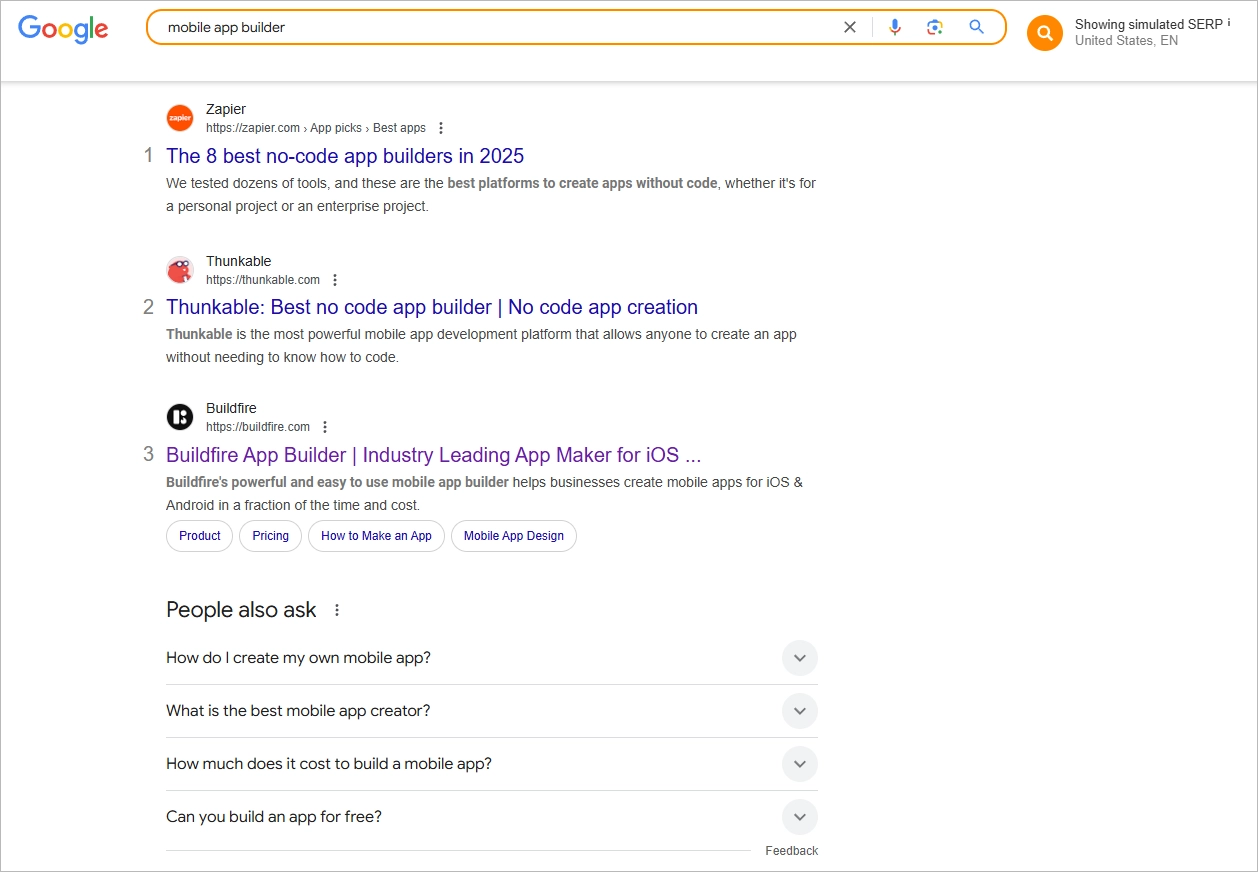
Or you can just type in Ahrefs “site explorer” your domain, for example https://buildfire.com/, and Ahrefs will show this:

If you scroll down, you will see the “Top Organic Competitors” section. Here, Ahrefs will analyze common keywords and provide a list of websites with businesses similar to yours. This is not always working well, as you can see, there is also Zapier, which is just ranking for every keyword related to any type of software.
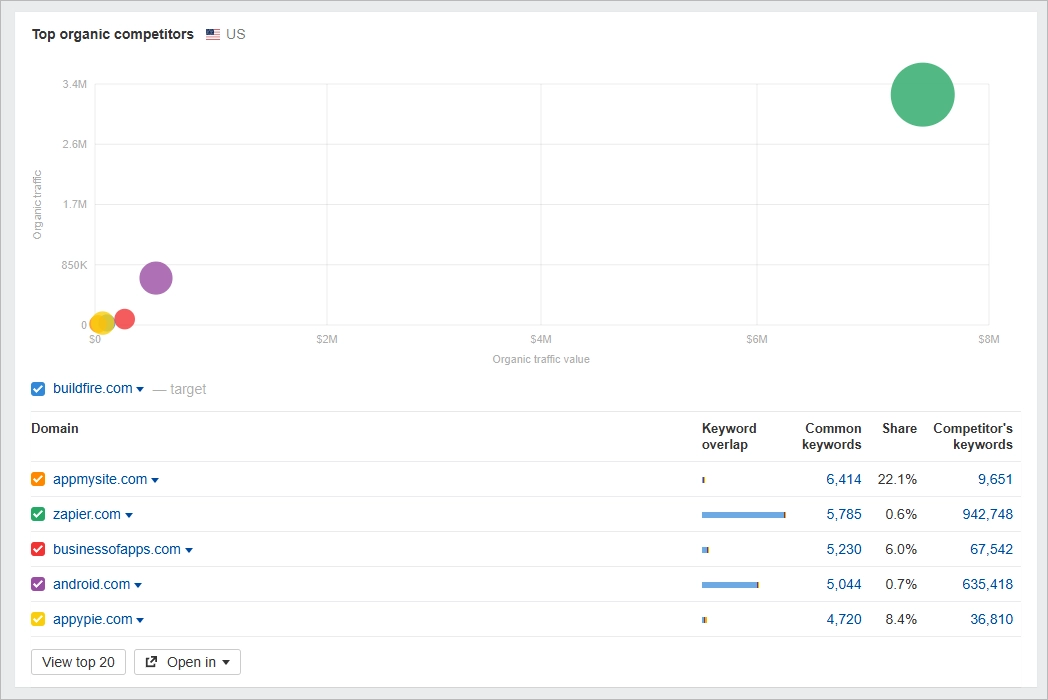
I prefer checking those competitors based on the main keywords related to the product, so competitors for https://buildfire.com/ will be https://apphive.io/. It looks like they are both no-code app builders.
Check the pages and topics they are covering with Site Explorer:
You’ll notice something interesting – they are ranking #1 for the keyword “app maker” with their homepage. This suggests that they are perfectly satisfying the search intent for this query. Out of their 52K organic monthly traffic, 40K visits go directly to their homepage, likely because they cover every aspect of app creation intent – from event apps and health apps to food apps and real estate apps. They also offer a free app maker, which further strengthens their positioning.
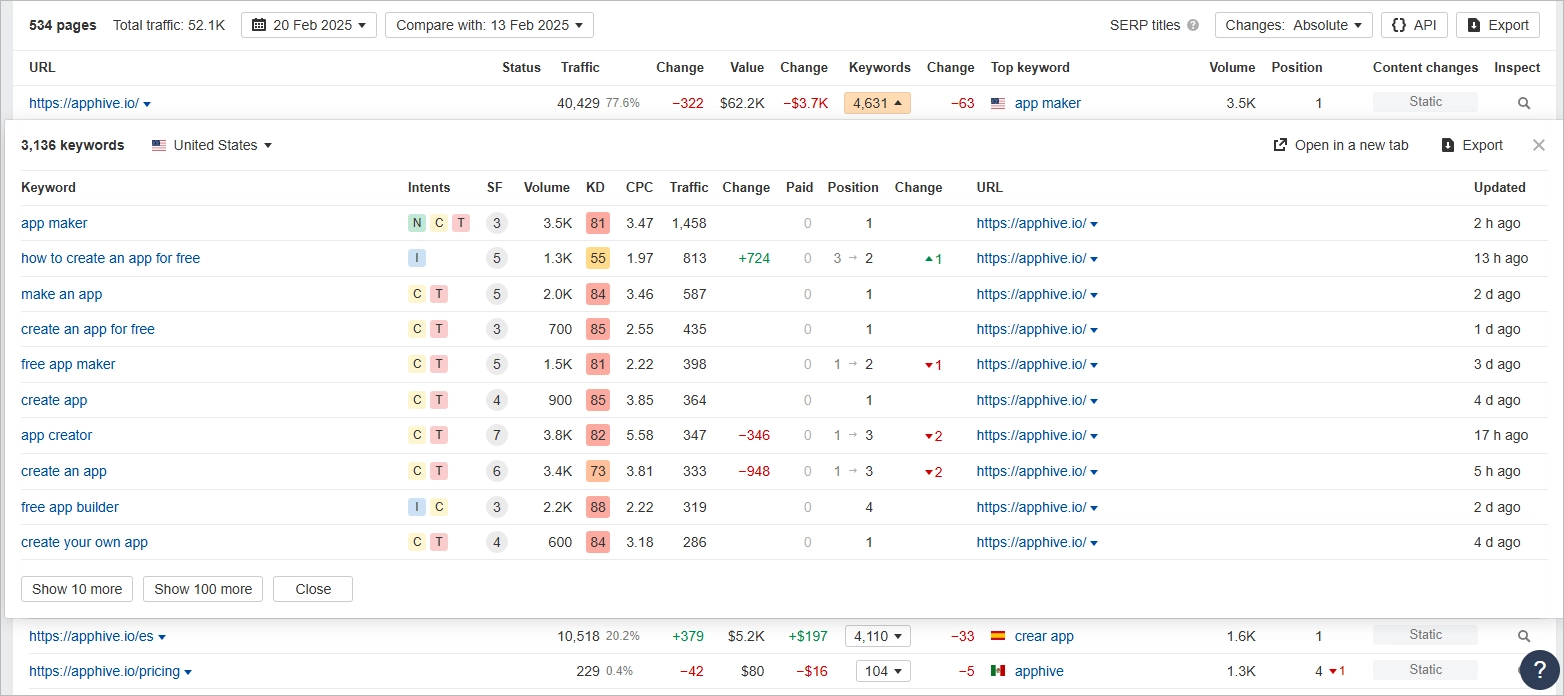
Additionally, they are leveraging international SEO by translating their website into Spanish, which helps reduce the cost of ranking in search engines while effectively targeting the U.S. market, which has a large Spanish-speaking audience.

They are not building topical authority, but they are effectively addressing search intent for this type of product. Despite having a low-authority site (33 DR and 20 UR), they have managed to rank a four-year-old website at the top of Google for keywords with a difficulty score of 90+ according to Ahrefs.
On the other hand, you can see https://buildfire.com/ with high topical coverage and topical authority with 77 DR and 32 UR, according to Ahrefs. Aggregating over 56,000 monthly organic traffic and ranking on top search results for a generic topic like:
- How to create an app
- Mobile app ideas
- How to code a mobile app
- Ecommerce app development
- Food delivery app development
BuildFire should focus on translating its website into Spanish and optimizing its product pages. Enhancing product pages is crucial, as they attract high-intent users who are ready to make a purchase.
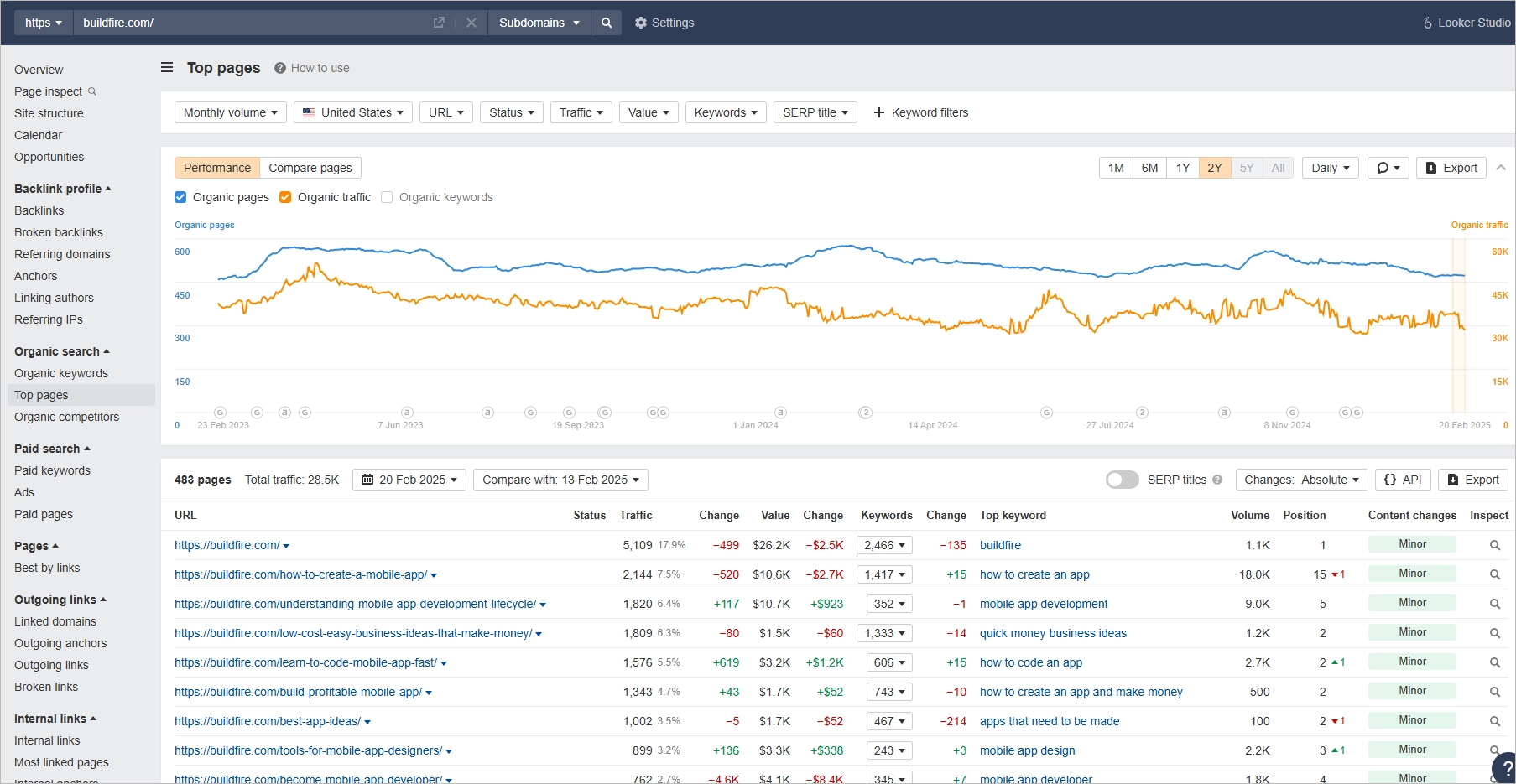
In SaaS, product sentiment plays a crucial role. When analyzing your competitors, you should also check their reviews on Google My Business, Trustpilot, G2, Capterra, and other review platforms, as these can significantly impact their search rankings.
As you can see, these two SaaS websites follow opposite strategies and have different strengths. You should combine the best elements of both approaches to improve your rankings and outperform these strong competitors.
c) Create a proper topical map
A proper topical map helps search engines understand your expertise in a specific subject area and ensures you’re covering all the queries your audience is searching for. Start by identifying your core topics – usually based on your product’s key features, main use cases, or industries served. Then break each topic down into supporting subtopics that align with various stages of the buyer journey.
For example, if you offer time tracking software, your core topic might be “time tracking,” and subtopics could include “best time tracking tools,” “time tracking for remote teams,” “how to track billable hours,” and “Toggl vs Clockify.”
Use tools like Ahrefs, Semrush, or AlsoAsked to build these topic clusters based on what people actually search. Each cluster should include a pillar page (e.g., a comprehensive guide or product page) and supporting articles that link to it and reinforce its relevance.
A strong topical map isn’t just good for SEO – it also helps guide your content planning and ensures nothing important is missed.
d) Split your content into TOFU, MOFU, and BOFU
A solid SEO strategy involves aligning content with the buyer’s journey (TOFU, MOFU, BOFU), which is essential for boosting conversions.
- TOFU (Top of the Funnel) stage targets broad, informational searches like “What is CRM software?” or “CRM Benefits.” These searches indicate users are exploring a problem but aren’t ready to buy.
- MOFU (Middle of the Funnel) stage captures users comparing options, such as “HubSpot vs Salesforce” or “Best CRM for startups.”
- BOFU (Bottom of the Funnel) stage focuses on transactional searches, such as “Buy HubSpot CRM” or “Salesforce pricing.” Creating content for each stage ensures your SaaS business captures users at every step of their journey.
Correlative Queries are used by Google to determine which searches are commonly made together, even if the order is random. If many users search “best CRM software” and “CRM pricing comparison” within the same session, Google recognizes these topics as closely related. This helps SaaS companies structure their content clusters effectively.
For example, if a user searches for “email marketing automation,” Google may also associate it with searches like “Mailchimp vs ConvertKit,” understanding that these queries serve a similar intent.
Query Paths track the exact order in which users search, revealing how they progress from awareness to decision-making.
This sequence shows how users move through the funnel, helping marketers structure internal links and CTAs to guide visitors smoothly through TOFU, MOFU, and BOFU content.
For example, a blog post about “Best CRM tools” (TOFU) should link to a comparison page (MOFU) and then to a pricing page (BOFU).
Sequential Queries examine searches across multiple sessions, clustering related searches from the same user over time.
A potential customer might search “What is ERP software?” today, then “Best ERP for small businesses” a week later, and finally “SAP ERP pricing” when they are ready to make a purchase.
Google recognizes this pattern and prioritizes content that aligns with long-term user intent. SaaS companies should create interconnected content that nurtures users at different stages, ensuring they remain engaged throughout their buying journey.
I highly recommend checking Koray Tugberk Gubur’s Semantic SEO Course to better understand these concepts.
3. Prepare content briefs
Before producing content, create detailed briefs to align SEO goals with your writers’ output. A good content brief serves as a roadmap for both structure and intent.
It should specify the target keyword, the main and secondary topics to include, the search intent (informational, comparison, transactional), and the key questions to answer. It should also include notes on tone, internal linking opportunities, desired word count, and any reference URLs or SERP examples.
This helps writers stay focused, prevents content gaps, and ensures consistency across articles, even when multiple authors are involved. When every piece of SaaS content marketing is aligned with your topical map and buyer journey, your entire website gains relevance and authority in the eyes of search engines.
4. Train your authors with SEO writing rules
Even talented writers need SEO context. Train your authors on how to integrate keywords naturally, structure headings for scannability, and avoid issues like keyword cannibalization or duplication. Teach them to think beyond keywords – toward satisfying intent.
Writers should know how to optimize title tags, meta descriptions, and image alt text without overstuffing. They should understand how to use structured data where applicable and how to embed internal links that guide readers through the TOFU-MOFU-BOFU journey.
You can build internal documentation or short training sessions to cover these basics. The more SEO-aware your writers are, the less cleanup and editing you’ll have to do later, and the better your content will perform from day one.
5. Publish your content with high frequency
Publishing frequency matters more than most teams realize. In the early stages of SaaS SEO, a high publishing rate accelerates topic coverage and helps your site gain visibility faster.
Aim for 2–4 high-quality articles per week, especially if your competitors are already ranking well. Consistency signals to Google that your site is active, relevant, and worth crawling more frequently. It also helps build topical authority – each new article adds context to others and strengthens your overall structure.
If you can’t maintain a high publishing rate internally, consider hiring freelance writers or working with an agency to fill the gaps. But make sure quality stays high. Poor content will only slow you down.
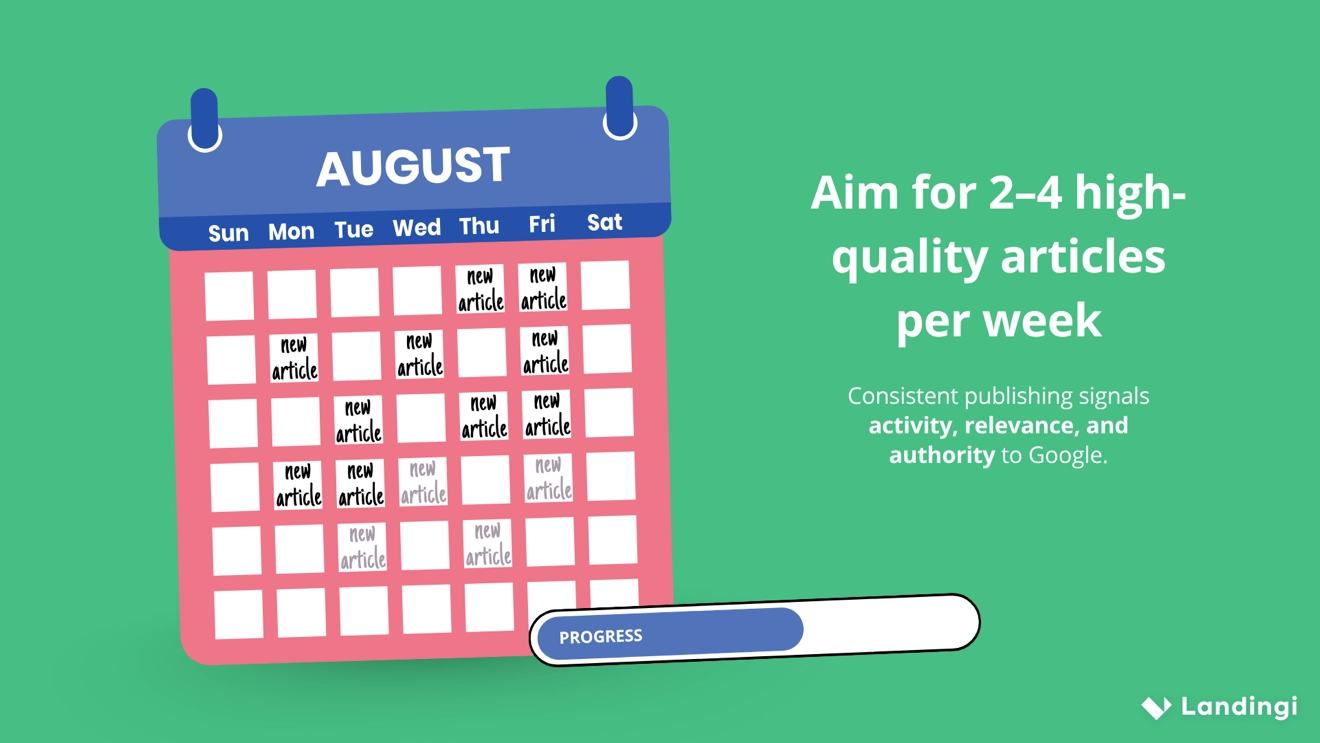
6. Improve E-E-A-T
Google rewards websites that demonstrate real Experience, Expertise, Authoritativeness, and Trust. Improving your E-E-A-T isn’t about tricks – it’s about being credible and showing that your content is created by people who know the subject.
a) Create a proper About page
Your About page should clearly state who you are, what your product does, and why visitors can trust your company. Define the main entity behind the website (person or company), and make sure it connects with other signals like author bios and external mentions. This helps Google establish source context.
b) Create author pages and author bios
Author pages are not just vanity. They show real people stand behind the content. Include bios that highlight each writer’s background, experience in SaaS or digital marketing, and links to their social profiles or other publications. This builds credibility and makes your content more trustworthy, especially for YMYL (Your Money or Your Life) topics or B2B decision-making content.
If you’re publishing under a brand name only, consider attributing content to team members or guest contributors when appropriate.

7. Perform content purging
Perform content purging to improve the traffic per web page metric. Over time, your website may accumulate blog posts, landing pages, or support articles that no longer bring value. These low-performing pages can dilute your topical authority, confuse search engines, and waste your crawl budget.
Start by auditing your content using tools like Google Search Console, Ahrefs, or Screaming Frog. Identify pages that receive zero or near-zero organic traffic over the past 6 to 12 months. Then decide whether to update, consolidate, redirect, or remove them.
For example, several similar blog posts targeting overlapping keywords might be merged into one comprehensive guide. Or an outdated feature announcement page might be redirected to a current product page.
Purging helps search engines focus on your best-performing and most relevant content. It also improves your site’s efficiency by tightening internal linking, boosting crawlability, and making the overall user experience cleaner.
8. Optimize for conversion
Once you start bringing in qualified organic traffic, your next job is to convert those visitors. SEO is part of the funnel – but not the whole funnel.
Every content asset should have a clear goal. Is it to capture emails? Book a demo? Start a free trial? Align your calls to action (CTAs) with the intent behind the keyword. TOFU content may benefit from soft CTAs like lead magnets or email signups. BOFU content should drive users directly to pricing, signups, or product pages.
Test CTA formats (buttons, banners, inline links), placement (top, middle, end), and messaging to see what converts best. Also, optimize your landing pages, trial flows, and forms for minimal friction. A well-optimized page can double your ROI from SEO traffic without increasing your rankings.
Your CTA might be costing you leads. Run A/B tests to find out what really works.
9. Refresh your content
Update your content every 6 months to keep a freshness signal from Google. Search engines favor recently updated pages, especially in industries where products evolve quickly, like SaaS.
Refreshing content isn’t just about changing the publish date. It’s about improving the quality, accuracy, and relevance of what you already have. That might include:
- Adding recent stats, use cases, or product updates
- Rewriting outdated sections
- Replacing broken or low-quality external links
- Updating screenshots, feature names, or UI references
- Expanding the content to better match search intent
You can also reshare and repromote the updated page, giving it a second life and drawing new engagement signals. Use traffic drops, keyword loss, or SERP changes as signals to prioritize updates. This ongoing effort helps you defend your rankings and outpace competitors who publish once and never revisit their content.
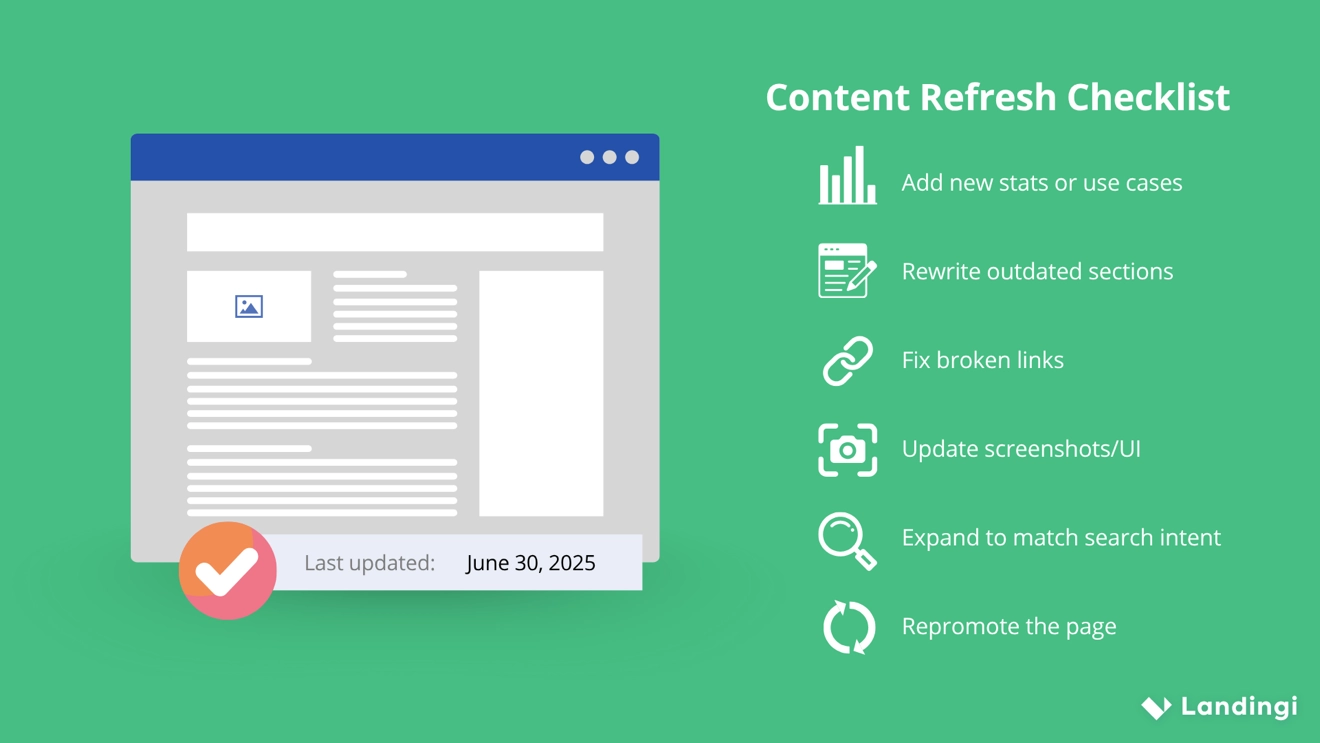
How to Perform SEO Audit for SaaS Company?
To perform SEO audit for SaaS company, review the technical setup, on-page elements, content quality, backlinks, and conversion paths to identify what’s blocking organic growth and how to fix it.
An SEO audit helps you understand how well your site is performing from a search engine’s perspective. For SaaS businesses, it’s not just about visibility – it’s about whether your pages are driving the right kind of traffic and supporting the user journey from discovery to conversion. Here’s how to break it down:
1. Crawl your site like a search engine
Use tools like Screaming Frog to scan your SaaS website. Look for broken links, redirect chains, duplicate content, missing meta tags, and slow-loading pages. Ensure key pages are indexable and correctly linked.
2. Review technical SEO setup
Check your sitemap and submit it in Google Search Console. Verify canonical tags, structured data, mobile usability, and site architecture. Make sure your pages are easy to crawl and your site follows SEO best practices.
3. Analyze Core Web Vitals
Use PageSpeed Insights or Lighthouse to test loading speed, visual stability, and interactivity, especially on mobile. Uncompressed images, too many scripts, or large page sizes can hurt rankings.
4. Check content structure and coverage
Make sure you have content for each stage of the funnel. Use Ahrefs or Semrush to identify content gaps or missing topics. Ensure your TOFU blog posts link to MOFU and BOFU pages, like comparisons and pricing.
5. Evaluate backlinks and authority
Analyze your backlink profile. Look for quality links from relevant domains. Identify lost or toxic links and review competitor link sources to find new outreach opportunities.
6. Review conversion-focused elements
Check that CTAs are clear and match the search intent of each page. Make sure forms work, trial/signup flows are smooth, and key pages are connected through internal links.
7. Find duplicate or cannibalizing pages
Use SEO tools to locate pages competing for the same keyword. Merge, redirect, or optimize to avoid ranking conflicts and improve content clarity.
Run a full audit twice a year to fix issues, improve performance, and stay aligned with search engine expectations.
Organic traffic is great—but what makes it stick? Find the friction points with EventTracker.
How to Perform Keyword Research for SaaS SEO?
To perform keyword research for SaaS SEO, identify queries your audience uses at each stage of the buying process and group them into content types that match intent – educational, comparative, or transactional.
Start by listing product-related terms, features, and problems your tool solves. Use tools like Ahrefs, Semrush, or Google Search Console to find real queries people search. Then analyze the intent: someone searching “best CRM for freelancers” is comparing options (MOFU), while “HubSpot pricing” indicates a decision-making stage (BOFU). Cover all stages by building out clusters of related keywords. For example, “email automation tools” → “Mailchimp vs ConvertKit” → “ConvertKit trial”.
Always check the actual SERP for each keyword to verify what Google is rewarding (blog posts, landing pages, directories, etc.) and mirror that format with better content.
Skale shares their 11 methods for conducting SaaS SEO keyword research – take a look:
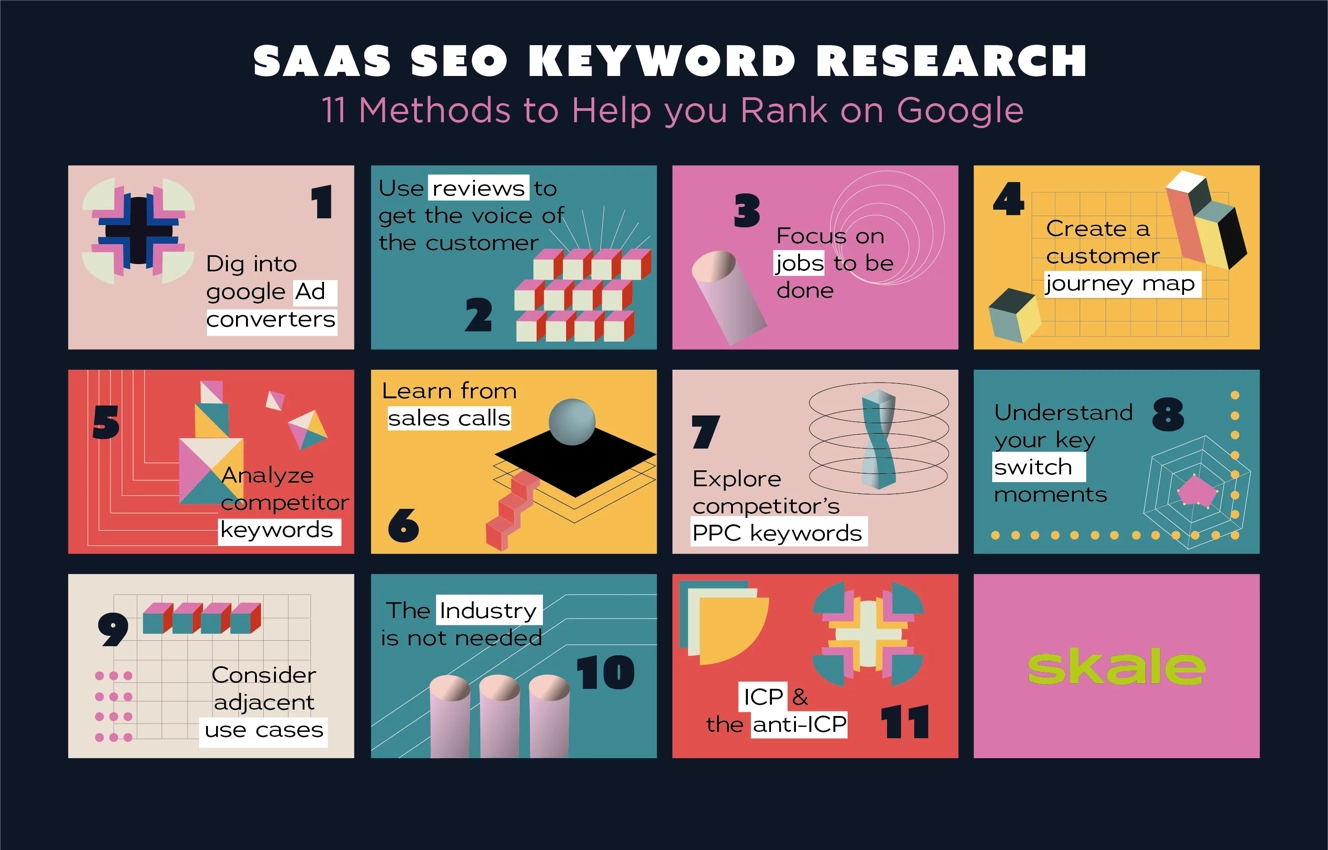
What is the Difference Between SaaS SEO and Traditional SEO?
The difference between SaaS SEO and traditional SEO lies in how the strategies align with long sales cycles, recurring revenue models, and the need to educate users about often complex digital products. Traditional SEO may focus on ecommerce, local, or content-only goals, while SaaS SEO must support both product discovery and user onboarding – guiding visitors from awareness to activation.
SaaS SEO requires full-funnel content and precise keyword targeting across TOFU, MOFU, and BOFU stages. It’s not enough to drive traffic; you need to attract the right personas, answer specific software-related questions, and nudge visitors toward trial or signup.
SaaS sites also often face issues like feature overlap, fast-paced product changes, and international audiences, which demand more frequent updates, deeper topical coverage, and a tighter link between SEO and product marketing.
Below is a table showing the differences between SaaS SEO and traditional SEO, as created by SeoProfy:
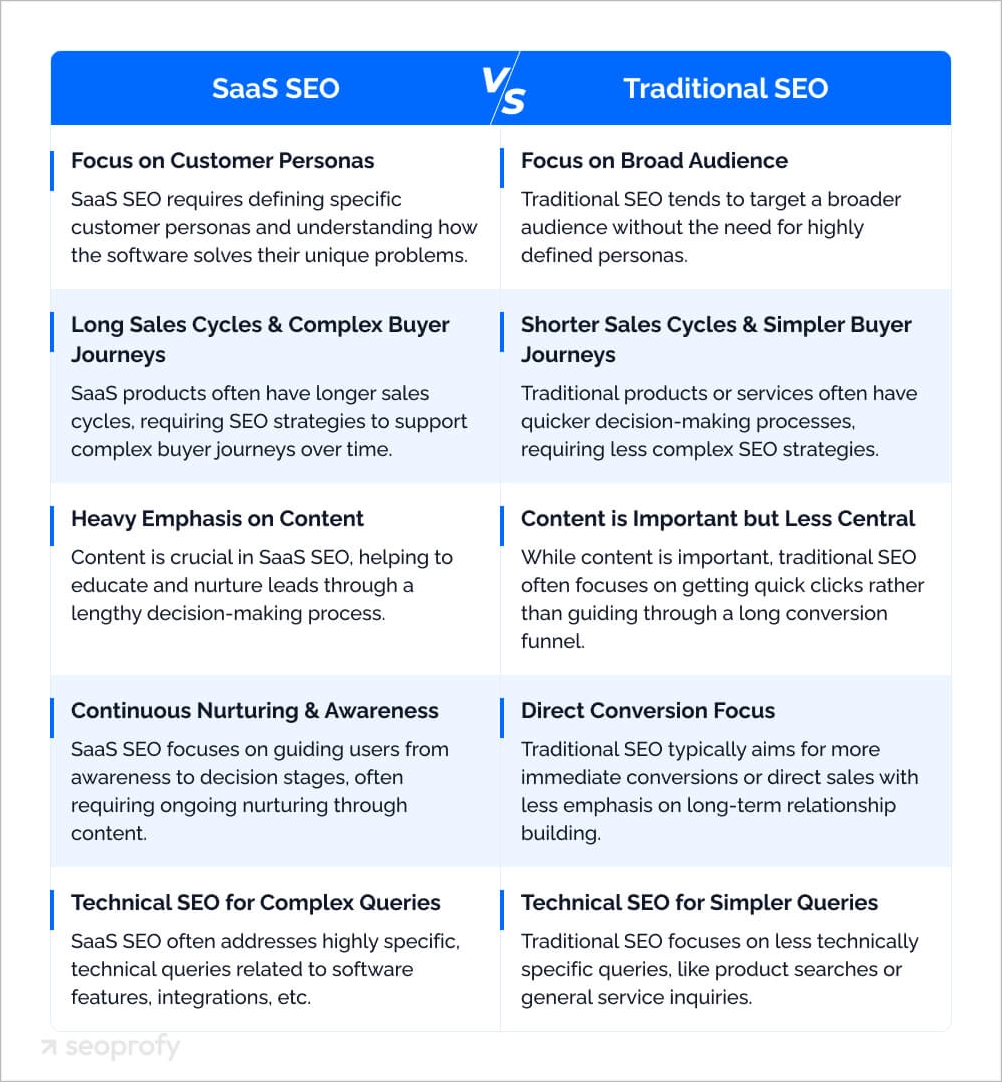
What is B2B SaaS SEO?
B2B SaaS SEO is the process of driving organic traffic to business-focused software websites by ranking for keywords that match how companies research and evaluate tools. Unlike B2C SaaS, where users can make instant decisions, B2B buyers take longer to convert and involve multiple stakeholders. That’s why B2B SaaS SEO focuses heavily on educating, comparing, and building trust.
Effective B2B SaaS SEO includes targeting broader topics to attract top-of-funnel attention, creating comparison pages like “Product A vs Product B,” and offering in-depth guides or case studies for more advanced prospects. It also involves optimizing product and solutions pages for industry-specific terms like “project management software for agencies” or “CRM for real estate.” The goal is to reach decision-makers at every stage (from the initial search to the final vendor shortlist) and guide them toward a trial, demo, or sales conversation.
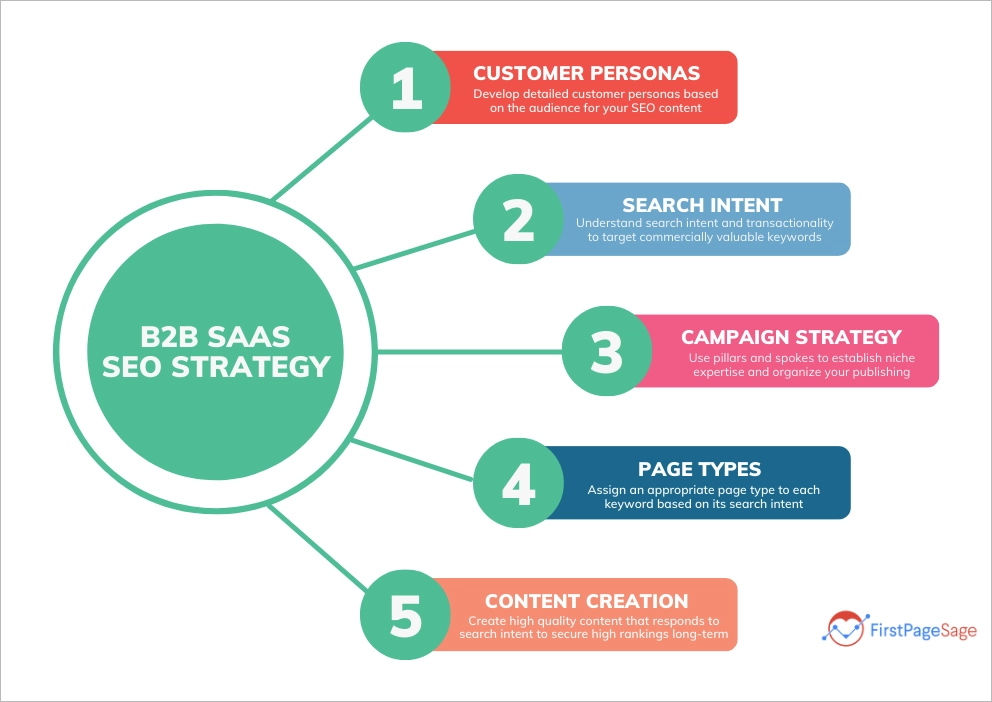
How to Choose SaaS SEO Consultant?
To choose a SaaS SEO consultant, look for someone with proven experience in scaling traffic and conversions for software businesses, not just general SEO knowledge. SaaS SEO involves understanding complex buyer journeys, subscription models, and the nuances of TOFU-MOFU-BOFU content creation. A good consultant should know how to structure topical authority, match content to search intent, and prioritize keywords that align with high-intent use cases, not just vanity traffic.
Ask for case studies specific to SaaS or tech, not just local or ecommerce projects. Review how they handle technical SEO for fast-growing platforms, how they build content strategies that drive trials or demos, and what kind of tools and workflows they use.
The best SaaS SEO consultants can bridge the gap between technical audits, content strategy, and business growth. Ideally, they should also collaborate with your content or product marketing teams to align SEO efforts with broader marketing and product goals.
What are the Best SaaS SEO Tools?
The best SaaS SEO tools include Ahrefs, Semrush, Google Search Console, Screaming Frog, Surfer SEO, Clearscope, Frase, Content Harmony, Hotjar, and Microsoft Clarity. These tools cover everything from keyword research and competitor analysis to technical audits, content optimization, and user behavior tracking – key areas for building a successful SaaS SEO strategy.
Ahrefs and Semrush help you identify high-intent keywords, analyze competitors, track rankings, and uncover link-building opportunities. Screaming Frog is ideal for crawling your site and spotting technical issues like broken links or redirect chains. Google Search Console gives visibility into indexing, performance, and crawl errors. Surfer SEO and Clearscope help fine-tune content to rank better, while Frase and Content Harmony speed up the content brief process. Hotjar and Microsoft Clarity provide insights into how users interact with your pages, helping you improve engagement and conversions.
Your SEO tools bring the traffic. Let your landing pages close the deal.
What are the Limitations of SaaS SEO?
The limitations of SaaS SEO include long time to results, heavy content demands, and the challenge of aligning content with fast-changing product features. Unlike paid acquisition, SEO doesn’t deliver instant leads. It can take several months to see meaningful traffic, especially in competitive niches. This delay can be hard to manage for early-stage SaaS companies that need quick wins or rely on short sales cycles.
Another limitation is that SEO requires consistent content production and frequent updates. SaaS products evolve quickly (features get added, pricing changes, competitors shift), which means your content can go out of date fast. Maintaining accuracy and relevance takes ongoing effort. There’s also the risk of chasing traffic that doesn’t convert if your strategy prioritizes volume over intent. Without strong coordination between SEO, content, and product marketing, it’s easy to build visibility that doesn’t lead to actual growth.
What’s the Role of Landing Pages in SaaS SEO?
The role of landing pages in SaaS SEO is to target high-intent, conversion-focused keywords and guide visitors toward specific actions like signing up, booking a demo, or starting a trial. Unlike blog posts, which usually serve informational intent, landing pages are designed to convert. They often rank for BOFU keywords such as “CRM software for startups,” “email marketing tool pricing,” or “[Product] free trial.” These are queries from users who are closer to making a decision, and landing pages help turn that intent into action.
They should be keyword-specific, have unique meta titles and H1s, include structured internal links, and match search intent precisely. Many SaaS companies also create multiple landing pages targeting specific industries, use cases, or user types – like “project management tool for nonprofits” or “analytics software for ecommerce.”
These pages not only improve rankings for niche queries but also boost relevance and conversions by speaking directly to different segments of your audience.
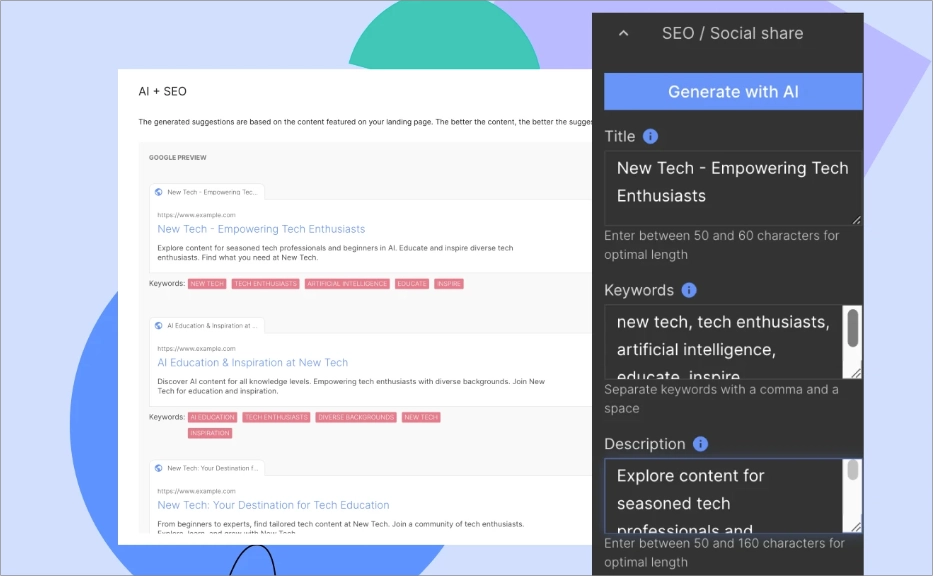
Landing pages also serve as a bridge between organic discovery and product engagement. If someone finds your blog post through a TOFU search and clicks a CTA, they should land on a page that’s optimized both for SEO and conversion. The page should have clear, benefit-focused messaging, highlight your unique value, and include trust elements like testimonials or badges. To support rankings, it also needs proper internal links, a clear keyword focus, and fast loading times. A well-built landing page doesn’t just rank – it turns visitors into leads or users.
Blog traffic is nice. Conversions are better. Build pages for BOFU keywords that drive trials, demos, and sign-ups.
Use SaaS SEO to Improve Traffic on Your Landing Pages
To improve traffic on your landing pages using SaaS SEO, treat them as integral parts of your content architecture, not isolated assets. Many SaaS companies focus SEO efforts solely on blogs and forget that landing pages can rank too, especially for transactional keywords. Build pages around specific use cases, features, or industries, and target long-tail, high-intent queries like “best accounting software for freelancers” or “email automation tool with AI.” These are the pages that capture users ready to evaluate and convert.
If you’re looking for an easy way to build SEO-optimized landing pages at scale, consider using a platform like Landingi. It lets you create, duplicate, and manage landing pages quickly, without relying on developers. With built-in optimization features and flexible user management, it’s a great solution for SaaS teams that want to test, iterate, and grow traffic efficiently. You can try Landingi for free and see how it fits into your SaaS SEO strategy.



